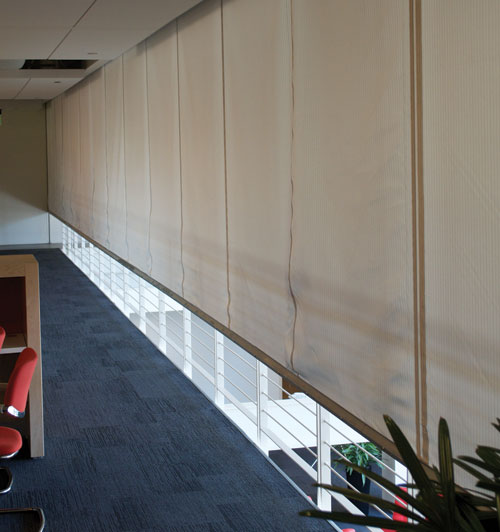Fire and Smoke Curtains: Meeting Atrium Code Requirements
Smoke Management Systems
Smoke management is required within atrium spaces connecting more than two stories (per IBC Section 404.4.) and requires all smoke control systems to be tested by a special inspector who shall have expertise in fire protection engineering (Section 909.18.8.)
Given the large volume of open space in an atrium, smoke control is the most critical design issue. Many sources report that as many as 76 percent of deaths and injuries that occur as a result of a fire are caused by smoke.
Smoke management or smoke control systems can be active, passive, or a combination of both active and passive measures. The fire protection engineer or professional system designer has the latitude to use these options without relying on the building code to spell out how this can be done. One code requirement is to address means of egress. This is typically accomplished by designing the smoke control system so as to keep smoke away from egress or escape paths.
Active System: Smoke Exhaust or Evacuation. The conventional widely used solution to smoke control is a smoke exhaust or evacuation system. This is considered an "active" system because it uses mechanical equipment to control the spread of smoke. Exhaust inlets located near the ceiling remove smoke at a rate that is greater than or equal to the rate at which it is generated, or at a rate which will allow people to evacuate the building.
Designing a smoke exhaust system is a complex engineering exercise that includes calculations regarding the size of exhaust and replacement air, number and size of exhaust fans and intake vents, smoke plume equations and meeting the current requirement of maintaining a smoke layer height of 6 ft above the highest walking surface.
IBC also requires that a registered professional develop a design fire size of 5,000 Btus, as part of the analysis (a design fire is an engineered description of a fire over time.) One potential problem is over-designing the exhaust system, which may lead to "plugholing" (where a relatively shallow smoke layer and too-high exhaust rate can lead to entrainment of cold air from the clear layer, thus blocking smoke from being exhausted.)
Smoke exhaust systems may have a dedicated power source, or draw on the building's power source and mechanical systems. In either case, a standby power source is required in the event of loss of power. For these reasons, an active smoke exhaust system uses more energy than a passive system such as flexible smoke curtains (see next section in online portion). See Case Studies 1 and 2 for examples of smoke exhaust systems and their required fans, ducts, dampers, power and control systems.
 |
This example of a large-opening automatic flexible smoke-rated curtain has zero percent residual opening when activated and employs a gravity fail-safe system. Photo courtesy of Smoke Guard, Inc. |









